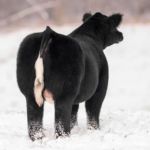The phone jolted us awake at 2 AM… it was Hereford heifer show day in Denver. When it rang, we assumed it was just the wakeup call but the conversation that followed had everyone awake in a hurry. We were traveling with a guy whose bulls kept getting loose on the trailer ride to Denver. That night in tie-outs, they were loose again and as we found out from the call, Mary Lee White was irate. For any of you who know Mary Lee, you know this is not a position in which you EVER want to find yourself. She had a really nice May heifer calf that had been bred that night in tie outs by our traveling companion’s bull. As you’d expect, she was all humped up for the show and ended up like dead last in class that day. Mary Lee brought over a couple leather neck collars for him to use and those bulls wore the neck collars for the remainder of the trip. Our traveling companion spent most of that day in the Maine-Anjou barn.
Most county fairs require the use of a neck rope, but did you know that used improperly, they can be very dangerous? I know, we live in a world where the tide pods come with ridiculous “adult proof” packaging and everyone is overly cautious about everything, but this is the real deal.
Used properly, neck ropes are critical for multiple reasons. It’s easy for a calf or a bull to slip his halter in the middle of the night and head out to wander. Also, they keep cattle where they should be in the beds at a show. They will keep the calves from sharing “breakfast” with their neighbor when they are uninvited or standing sideways in the bed. We’ve always used neck ropes, but learned a very valuable lesson in tie outs one year at California State Fair. We had a two-year-old Angus bull that almost choked to death when the rings on the neck rope slipped and cinched down on his neck. Thankfully, Darrell Hansen and Big Jim had arrived to the grounds earlier than us and found him.
You see, neck ropes typically come with two rings and the rope threads between them. However, the rings can slip and then tighten down on their necks, choking them. New ropes are particularly slippery, as I’m sure you’ve found.
From that day on, we do one of two things with neck ropes. We will either leave both rings in them and tie a knot around a ring so it can’t slip, or take one ring completely off and tie a knot in the rope around the remaining ring. If you walk through the barn, 99% of cattle won’t have a knot around the ring because most people don’t know to do it.
Another huge potential danger is how they are tied in the first place. The neck rope of a particular animal should NEVER be tied on the tie rail to left side of the halter rope. It ALWAYS goes to the right, creating a sort of triangle from where the halter is tied, to the calf’s head and then the where the neck rope is tied.
This year at our county fair, there was a dairy heifer who was tied both incorrectly and too long. The ropes wrapped around her leg overnight and cut into her leg so badly that she actually had to be put down. I’m telling you, it is a big deal to get this right. If you are unsure if you have your cattle tied correctly, go ask someone who you know is savvy on this topic at the show.
So we’ve discussed what not to do, let’s cover what to do!
1. Get your neck rope and adjust it to fit your calf. Either take one of the rings out and tie a knot in it, around the ring or leave the rings and tie a knot around one of the rings.
2. Tie your halter on the left side of the calf and the neck rope on the right. Be sure that the rope isn’t going to slip back and forth on the tie rail. You want your halter rope and neck rope to be roughly 3-4 feet apart. This will depend on what you have to tie to at the show.
Would you like more specific info on adjusting and tying the neck rope? We will have a tip sheet with pictures up for you to download. Please sign up for our email list so we can let you know when it is available.






